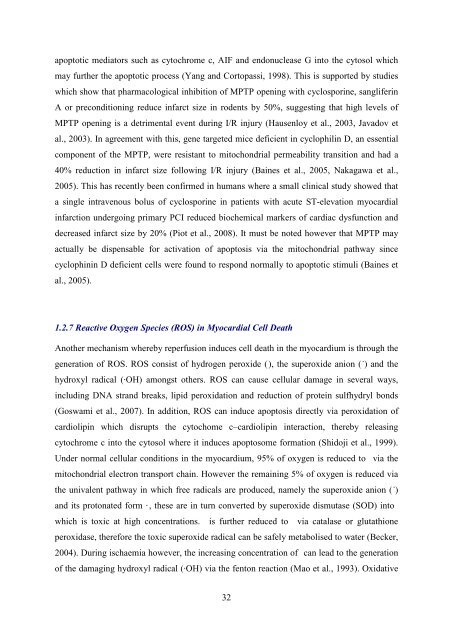Investigating the role of the JAK/STAT and MAPK ... - UCL Discovery
Investigating the role of the JAK/STAT and MAPK ... - UCL Discovery
Investigating the role of the JAK/STAT and MAPK ... - UCL Discovery
Create successful ePaper yourself
Turn your PDF publications into a flip-book with our unique Google optimized e-Paper software.
apoptotic mediators such as cytochrome c, AIF <strong>and</strong> endonuclease G into <strong>the</strong> cytosol which<br />
may fur<strong>the</strong>r <strong>the</strong> apoptotic process (Yang <strong>and</strong> Cortopassi, 1998). This is supported by studies<br />
which show that pharmacological inhibition <strong>of</strong> MPTP opening with cyclosporine, sangliferin<br />
A or preconditioning reduce infarct size in rodents by 50%, suggesting that high levels <strong>of</strong><br />
MPTP opening is a detrimental event during I/R injury (Hausenloy et al., 2003, Javadov et<br />
al., 2003). In agreement with this, gene targeted mice deficient in cyclophilin D, an essential<br />
component <strong>of</strong> <strong>the</strong> MPTP, were resistant to mitochondrial permeability transition <strong>and</strong> had a<br />
40% reduction in infarct size following I/R injury (Baines et al., 2005, Nakagawa et al.,<br />
2005). This has recently been confirmed in humans where a small clinical study showed that<br />
a single intravenous bolus <strong>of</strong> cyclosporine in patients with acute ST-elevation myocardial<br />
infarction undergoing primary PCI reduced biochemical markers <strong>of</strong> cardiac dysfunction <strong>and</strong><br />
decreased infarct size by 20% (Piot et al., 2008). It must be noted however that MPTP may<br />
actually be dispensable for activation <strong>of</strong> apoptosis via <strong>the</strong> mitochondrial pathway since<br />
cyclophinin D deficient cells were found to respond normally to apoptotic stimuli (Baines et<br />
al., 2005).<br />
1.2.7 Reactive Oxygen Species (ROS) in Myocardial Cell Death<br />
Ano<strong>the</strong>r mechanism whereby reperfusion induces cell death in <strong>the</strong> myocardium is through <strong>the</strong><br />
generation <strong>of</strong> ROS. ROS consist <strong>of</strong> hydrogen peroxide (), <strong>the</strong> superoxide anion ( - ) <strong>and</strong> <strong>the</strong><br />
hydroxyl radical (·OH) amongst o<strong>the</strong>rs. ROS can cause cellular damage in several ways,<br />
including DNA str<strong>and</strong> breaks, lipid peroxidation <strong>and</strong> reduction <strong>of</strong> protein sulfhydryl bonds<br />
(Goswami et al., 2007). In addition, ROS can induce apoptosis directly via peroxidation <strong>of</strong><br />
cardiolipin which disrupts <strong>the</strong> cytochome c–cardiolipin interaction, <strong>the</strong>reby releasing<br />
cytochrome c into <strong>the</strong> cytosol where it induces apoptosome formation (Shidoji et al., 1999).<br />
Under normal cellular conditions in <strong>the</strong> myocardium, 95% <strong>of</strong> oxygen is reduced to via <strong>the</strong><br />
mitochondrial electron transport chain. However <strong>the</strong> remaining 5% <strong>of</strong> oxygen is reduced via<br />
<strong>the</strong> univalent pathway in which free radicals are produced, namely <strong>the</strong> superoxide anion ( - )<br />
<strong>and</strong> its protonated form ·, <strong>the</strong>se are in turn converted by superoxide dismutase (SOD) into<br />
which is toxic at high concentrations. is fur<strong>the</strong>r reduced to via catalase or glutathione<br />
peroxidase, <strong>the</strong>refore <strong>the</strong> toxic superoxide radical can be safely metabolised to water (Becker,<br />
2004). During ischaemia however, <strong>the</strong> increasing concentration <strong>of</strong> can lead to <strong>the</strong> generation<br />
<strong>of</strong> <strong>the</strong> damaging hydroxyl radical (·OH) via <strong>the</strong> fenton reaction (Mao et al., 1993). Oxidative<br />
32
















